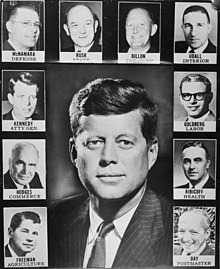Presidential transition of John F. Kennedy
Outgoing president Dwight D. Eisenhower and his administration cooperated with President-elect Kennedy and his team on a number of aspects of the transition to facilitate the peaceful transfer of power.
[7] David W. Kendall, incumbent president Dwight D. Eisenhower's White House counsel, was key in establishing this project and bringing both major party candidates into the fold.
[7] Shortly after Kennedy received the Democratic Party's presidential nomination, he met with former Frankin Delano Roosevelt administration official James H. Rowe with the goal of discussing how he might prospectively deal with post-election matters.
[8] Kennedy then tasked Neustadt with elaborating on his memo by creating a report assessing post-election problems for presidents-elect, particularly those regarding organizing a White House staff.
[11] Dick Donahue was also tasked with assisting in the process of selecting planned presidential appointees as well as managing communications between the transition team and Vice President-elect Lyndon B.
To diffuse any similar tensions if they arose, Fred Dutton was brought into the transition in an initially unclear role to act as a sort of neutral figure.
One of the telegrams was sent to briefly congratulate the president-elect, and the second one saw Eisenhower both promise to cooperate on an orderly transfer of power and give proposals on how to proceed with one.
[22] In Eisenhower's second telegram, he offered to meet with Kennedy, "to consider problems of continuity of government and orderly transfer of Executive responsibility on January 20th from my administration to yours".
[23] He stated that Persons would be prepared to make arrangements by which representatives appointed by Kennedy could meet with heads of executive branch departments.
[23] Kennedy held his first post-election press conference on November 9, where he discussed the transition and announced, for the first time, the names of several individuals that he had selected for his administration.
[4] The following day, Kennedy and his team held a staff meeting in which they went over the three separate memos created by Clifford, Neustadt, and the Brookings Institution.
During the meeting, Persons agreed to Clifford's request to have the Kennedy team send an office manager to examine the organizational structure of Eisenhower's White House.
[27] Per instructions issued by Eisenhower several days after the two men's November 14 meeting, Persons kept a detailed written record of his activities in the transition.
[9][30] In response to tensions with Cuba, in March 1960, the Eisenhower administration approved the training of a group Cuban exiles to lead an overthrow of Castro's government.
[30] In 1987, historian Carl M. Brauer would fault the fiasco of the Bay of Pigs Invasion on Kennedy and his team having been too trusting of the bureaucratic experts in the government during the transition.
For instance, when Eisenhower decided on December 5 to put a pause on the nuclear arm negotiations that were taking place with the Soviet Union in Geneva, Secretary of State Christian Herter decided to inform Kennedy before informing the United Kingdom and the Soviet Union.
[32][33] Going into the transition, Kennedy and Eisenhower had both thought ill of one another, in large part due to conceptions of each other that were shaped by this generation gap.
[9][32][38] Eisenhower also shared insight into foreign leaders such as Charles de Gaulle, Harold Macmillan, and Konrad Adenauer.
[38] Clark Clifford and Wilton Persons also attended the group meeting in the Roosevelt Room, and White House Press Secretary James Hagerty and Kennedy advisor Pierre Salinger both joined to help write a joint statement to be released by the president and president-elect after the meeting.
Kennedy advisor Ted Sorensen would later write that Kennedy, "thought it was inappropriate, unwise, until he had full responsibility and information to participate in, commit himself to, or even comment or be consulted upon these actions being taken by the outgoing administration between election and inauguration – including a mission to western Europe to improve the payments balance and ending of all diplomatic relations with Cuba.
His wife, Jacqueline, due to give birth in three weeks (to their son John F. Kennedy Jr.), did not join him, as she had been advised by her doctors against traveling to Florida.
[52] On November 14, Kennedy traveled from Palm Beach to Key Biscayne, Florida to meet with Richard Nixon, who was both his presidential election opponent and the outgoing vice president.
[64] Kennedy believed that the establishment figures of the United States military were largely too obsessed with nuclear weapons, and too willing to utilize them.
[41] To avoid creating a conflict of interest regarding their roles in the transition, both Clifford and Neustadt attempted to remove themselves from consideration for positions in Kennedy's administration.
[25] However, before the end of the transition Neustadt ultimately would be designated to serve as the Kennedy White House's consultant on government organization.
Its average age is 47, making it the youngest of the twenieth century but six years older than the first Cabinet of the first President, George Washington.
[75] The chair of the Senate Judiciary Committee, James Eastland, had some liking for Robert Kennedy, but another influential southerner, Richard Russell Jr., was not favorably disposed.
[76] How important Johnson's intercession was is uncertain,[78] as still other southern Democrats, such as McClellan and Sam Ervin, embraced Robert Kennedy due to his past work on the Senate Labor Rackets Committee,[74][79] and overall the nomination was likely never in doubt.
[79] Kennedy, a Democrat, designated some Republicans for roles in his administration, including McGeorge Bundy, Douglas Dillon, and Robert McNamara.
[83] Kennedy rejected liberal pressure to select Adlai Stevenson II as secretary of state, instead choosing Dean Rusk, a restrained former Truman-administration official.



